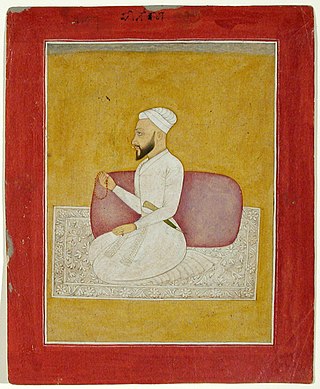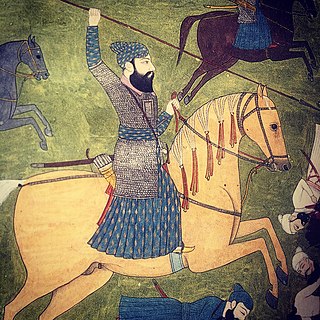
Raghunathrao Bhat, also known as Ragho Ballal or Raghoba Dada, was the younger son of Peshwa Bajirao I who served as the 11th Peshwa of the Maratha Empire for a brief period from 1773 to 1774. He succeeded his Nephew Narayanrao.

Hari Singh Nalwa was the commander-in-chief of the Sikh Khalsa Fauj, the army of the Sikh Empire. He is known for his role in the conquests of Kasur, Sialkot, Attock, Multan, Kashmir, Peshawar and Jamrud. Hari Singh Nalwa was responsible for expanding the frontier of Sikh Empire to beyond the Indus River right up to the mouth of the Khyber Pass. At the time of his death, Jamrud constituted the western boundary of the Empire.

The Battle of Jamrud was fought between the Emirate of Afghanistan under Emir Dost Mohammad Khan and the Sikh Empire under Maharaja Ranjit Singh on 30 April 1837. Afghan forces confronted the Sikh forces at Jamrud. The garrisoned army was able to hold off the Afghans till Sikh reinforcements arrived to relieve them.

Sardar Charat Singh, also romanised as Charhat Singh, was the founder of Sukerchakia Misl and father of Mahan Singh, and the grandfather of Ranjit Singh. He distinguished himself at an early age in campaigns against Ahmad Shah Abdali and along with 150 horsemen split from the Singhpuria Misl to establish the Sukerchakia Misl.
The siege of Multan began in March 1818 and lasted until 2 June 1818 as part of the Afghan–Sikh Wars, and saw the Sikh Empire capture the city of Multan from the Durrani Empire.

The Afghan–Sikh wars spanned from 1748 to 1837 in the Indian subcontinent, and saw multiple phases of fighting between the Durrani Empire and the Sikh Empire, mainly in and around Punjab region. The conflict's origins stemmed from the days of the Dal Khalsa, and continued after the Emirate of Kabul succeeded the Durrani Empire.

Adina Beg Khan was a Punjabi general and administrator who served as the last governor of the Punjab region of the Mughal Empire, including the provinces of Lahore and of Multan. He defeated Afghans after rising to power and was recognised as the Nawab of Punjab by Mughal emperor Alamgir II, who also gave him title of Jang Bahadur.
The Capture of Peshawar took place in the spring of 1758 when the Sikh Confederacy and the Maratha Empire defeated the Afghan forces led by Timur Shah Durrani. The Marathas and Sikhs were victorious and Peshawar was annexed into the Maratha Empire. Before that, the fort of Peshawar was being guarded by Afghan troops under Timur Shah Durrani and Jahan Khan. When Raghunathrao and Malhar Rao Holkar left for the Deccan, Tukoji Rao Holkar was given the charge of Peshawar with 10,000 Maratha troops.

The Afghan-Maratha War was fought between the Afghan Empire under Ahmad Shah Durrani and the Maratha Empire and the Sikh Confederacy between 1758 and 1761. It took place in north-west India, primarily the region around Delhi and Punjab.

Banda Singh Bahadur, was a Sikh warrior and a general of the Khalsa Army. At age 15, he left home to become an ascetic, and was given the name Madho Das Bairagi. He established a monastery at Nānded, on the bank of the river Godāvarī. In 1707, Guru Gobind Singh accepted an invitation to meet Mughal Emperor Bahadur Shah I in southern India, he visited Banda Singh Bahadur in 1708. Banda became disciple of Guru Gobind Singh and was given a new name, Gurbaksh Singh(as written in Mahan Kosh), after the baptism ceremony. He is popularly known as Banda Singh Bahadur. He was given five arrows by the Guru as a blessing for the battles ahead. He came to Khanda, Sonipat and assembled a fighting force and led the struggle against the Mughal Empire.

The Battle of Gurdas Nangal took place in April 1715 between the Sikhs, led by Banda Singh Bahadur, and the Mughal Army, led by Abd al-Samad Khan. Banda, at that time was carrying out operations and small raids to the north of Amritsar. During these operations, the Mughal Army confronted the Sikhs. When confronted, the Sikhs moved northward taking shelter in the fort of Gurdaspur. It had been recently extended to accommodate 60,000 horses, and stores of food, grain and fodder had also been collected there. The Mughal Army converged upon the fort from three sides. The Delhi force of 20,000 men under Qamar-ud-din Khan advanced from the east. The Governor of Lahore’s troops, consisting of 10,000 men under Abd al-Samad Khan, marched from the south. Finally, Jammu troops numbering nearly 5,000, under Zakariya Khan, approached from the north. To the west of the fort was the River Ravi, which had no bridge over it. All the boats had been withdrawn to the opposite bank, which was closely guarded by numerous local chiefs and Mughal government officials. The Mughal pursuit made it so the Sikhs could not enter the fort at Gurdaspur. Thus, the Sikh army quickly turned west.
The Battle of Sialkot took place on 12 November 1763, between the Durrani Empire, led by Jahan Khan, and the Sukerchakia Misl, led by Charat Singh, as part of the Afghan-Sikh wars which concluded with Sikh victory.

Ahmad Shah Durrani, the founder of the Durrani Empire, invaded Indian subcontinent for eight times between 1748 and 1767, following the collapse of Mughal Empire in the mid-18th century. His objectives were met through the raids and deepened the political crisis in India.

The Battle of Rahon was fought between Sikhs and Mughal Empire on 11 October 1710.
Sikh attacks on Delhi were common in the second half of the 18th century. The Sikhs attacked Delhi 19 times between 1766 and 1788.
Mian Qutb Shah or Qutb Khan was an Indian Muslim Sardar and formerly a collector of Saharanpur, Uttar Pradesh. He was best known as the slayer of Dattaji Rao Scindia.

The siege of Multan started in January 1780 and ended on 18 February 1780, it was the result Timur Shah Durrani's reconquest campaigns of Multan after it had been taken in 1772. This siege saw the Afghans successfully re-capture Multan after taking Rohtas months prior.
The Maratha–Patiala clashes were a significant chapter in Indian military history, in which two formidable powers, the Marathas and the Sikhs, collided in a series of engagements and battles. This period of conflict, often argued to be marked by strategic brilliance, fierce battles, and shifting alliances, occurred in 18th-century India—a time when regional powers vied for dominance and control.
The Battle of Kunjpura was fought on 17 October 1760, was a significant engagement during the Maratha-Afghan Wars. Led by the prominent Maratha commander Bhau marched towards Kunjpura, approximately 150 kilometers north of Delhi, due to high floods preventing the transportation of supplies from the Panjab, particularly from Sirhind. This was a significant temptation for Bhau to embark on the journey.











